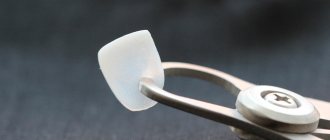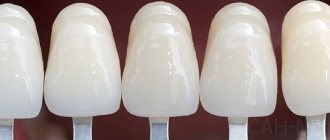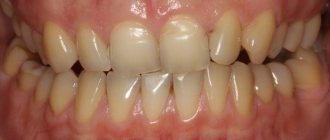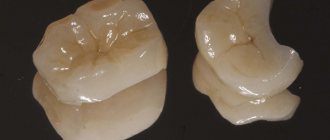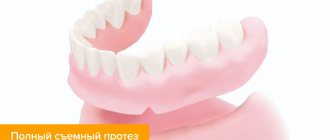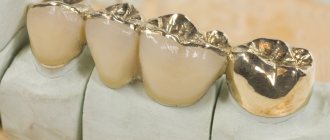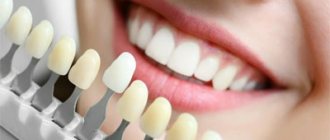The increased wear resistance of crowns allows for reliable protection of the tooth from further destruction. This design solves not only aesthetic problems, but also strengthens the tooth, which makes it possible to withstand increased loads in the chewing area. This effect can be achieved thanks to the design feature - the crown is completely placed on the tooth and protects it from external influences.
Crown installation is indicated in cases where:
- increased fabric abrasion;
- violation of the shape of the teeth or their location;
- tooth destruction by more than 50% or its complete loss.
In modern dentistry, crowns made of ceramics, metal-ceramics and zirconium are especially popular. The choice depends on the clinical indications, the location of the tooth and the wishes of the patient. It is recommended to install ceramic crowns on the front line, which give a natural look to the smile due to maximum translucency and similarity to a natural tooth. Ceramic and zirconium crowns cope well with the load in the chewing zone.
For the manufacture of crowns, only durable and hypoallergenic materials are used. With proper care and following all recommendations, crowns will last 10-15 years, after which they can be replaced with new designs.
What to choose for the restoration of the front row of teeth: crowns or veneers?
There are fundamental differences between veneers and crowns. Each type of restoration has its own characteristics and is used for varying degrees of damage to the dentition. Microprosthetics with veneers is a very popular and sought-after method of quickly transforming the front teeth. They are used only in the smile zone; outside of it, only crowns are placed. To decide what type of prosthetics to carry out: veneers or crowns, you need to know the purpose and functional features of the structures.
When is the best time to get crowns?
Crowns differ from veneers in their wear resistance; they can be installed on both front and chewing teeth. These caps are installed on a heavily ground tooth, pin or inlay. If the tooth is severely damaged or completely missing, doctors recommend installing a crown.
In order to install a crown, the doctor grinds down the tooth (removes about 2 mm of enamel). This procedure is painful, so anesthesia is required. If the tooth is severely damaged, but the root of the tooth allows you to install a crown, then it is placed on a pin. Then the dentist screws a pin into the gum canal or installs a metal tab, thus simulating the base of the tooth. A crown is placed on this structure (it can be made of any metal, even gold).
Nowadays, only the older generation has gold teeth, because it is not very aesthetically pleasing. Plastic crowns are placed temporarily, as are metal-plastic crowns, but the service life of the latter is slightly longer - up to 3 months.
Metal-ceramic crowns are considered the most durable and common option. Ceramic ones also look beautiful, but they are less durable than metal-ceramic ones. Crowns made of zirconium or lithium disilicate are quite durable and look visually aesthetically pleasing, like natural ones. Their only drawback is their high cost. The service life of crowns is from 10 to 15 years.
When is the best time to get veneers?
The installation of veneers involves covering the frontal group of teeth with the thinnest plates with a thickness of 0.2 to 0.7 mm. Veneers can be ceramic or composite; they are placed only on the front surface of the teeth, which makes the teeth beautiful and durable. Veneers are needed for those who have the following defects in the smile area:
- diastema (interdental gap)
- slight twisting, curvature and irregular shape of the tooth;
- the enamel has an uneven color, yellowness, spots, and all this cannot be bleached in the usual way;
- microcracks, chips;
- less than half of the teeth are destroyed;
- there are no significant shortcomings, I just want to have a Hollywood smile;
It should be especially noted that veneering is only possible if all the teeth in the row are present and they are not seriously damaged. The plates are attached to the native canine, so the tooth must have a sufficient layer of enamel and complete preservation of the lingual side. If this is not the case, you need to get crowns. Reasons for refusing to install veneers:
- Abnormal bite.
- Thinning enamel, severe tooth abrasion.
- Bruxism.
- Most of the tooth is destroyed or fillings have been placed on it.
- Passion for extreme sports.
To decide on the need to install veneers, you need to take into account contraindications and compare the veneered row of teeth and the usual one. The difference is noticeable, and the decision is made easier.
When is the best time to install crowns?
- With significant tooth decay.
From a functional point of view, crowns are considered a more reliable method, so it is better to cover serious chips and damage with crowns. In addition, veneers are strictly not recommended for pulpless teeth. - Frequent participation in contact sports.
If you cannot imagine your life without hockey, basketball or martial arts, it is better to choose more durable crowns to restore your teeth. - Bruxism and the habit of chewing on foreign objects.
In this case, installing veneers is very risky, but even crowns are not able to withstand such loads for a long time, so you need to get rid of bad habits or consult a doctor to treat bruxism.
Photos before and after installation of veneers
When should crowns be placed?
If the veneer is a microprosthesis, then the crown is a single or double prosthesis (two prostheses are connected), which covers not only the front part of the tooth, but the entire tooth on all sides. Crowns are mounted on implants, pins, or prepared teeth.
The main task of a crown is to strengthen a tooth that is destroyed, maintain its anatomical shape and provide it with chewing function. Crowns are installed in the following cases.
- The hard tissues of the tooth are very damaged and cannot be restored using filling materials.
- In case of pathological abrasion of teeth to prevent further destruction.
- Elimination of serious defects such as uneven color, irregular tooth shape, abnormal growth.
- An abnormal bite that cannot be corrected with braces.
- Deep cracks and the presence of caries.
- If you have loose teeth or a large interdental gap.
Thus, if there is serious damage to the teeth, only crowns should be placed. There are no other possibilities.
How are veneers different from crowns?
Before we talk about installing crowns or veneers, it is necessary to understand what their differences are. Veneers are thin plate-like coverings on teeth, which are fixed on the front surface of the teeth. Their main function is to hide unsightly teeth and create the effect of a “Hollywood smile.” Veneers hide all kinds of defects, strengthen the hard tissue of the tooth and protect the natural tooth from damage and darkening.
Such plates cover the vestibular part of the tooth. The onlay is firmly held due to the fact that the dentist first saws off the hard tissue along the outer surface and makes notches. In society you can see many people with a beautiful smile, but it is impossible to understand whether it is a natural tooth or a veneer. After all, modern records are aesthetically pleasing, and even upon close examination one cannot guess that there are veneers on the teeth. It will remain a secret.
Veneers are placed when teeth have chips, cracks, various cosmetic defects, stains, or the tooth is not very damaged. Doctors recommend installing plates on the front teeth or fangs, because installing veneers on molars is irrational.
Caps, called crowns, are placed on previously ground teeth. They cover five surfaces of the tooth, so it is protected from any influence. If the tooth is destroyed by more than 50%, that is, the natural tissues are almost lost, the dentist will recommend installing a crown. There are crowns made from different materials:
- ceramic;
- metal-ceramic;
- metal;
- plastic;
- zirconium.
It is clear that veneers or crowns are an opportunity to make a smile beautiful, but what is the difference between these two types of overlays? There are many differences, including the following:
- if the crown covers the entire tooth, covering it along the neck of the tooth, then the veneer is installed on top of the tooth only on its front surface;
- installation of veneers involves minor grinding of the tooth enamel, and sometimes (when choosing the appropriate veneers) filing of the surface is not required; to install a crown, it is necessary to grind the tooth when a large amount of tissue is removed - this is often required when installing a metal-ceramic structure;
- if the tooth is destroyed or there is a large filling, installation of veneers is impossible;
- veneers are placed from canine to canine, sometimes covering premolars that are visible when the patient talks or smiles; that is, veneers, unlike crowns, are not placed on chewing teeth;
- The crown not only protects the tooth, but also strengthens it and allows it to withstand increased loads.
How to choose materials?
When it comes to the restoration of anterior teeth, in addition to the functional characteristics of the structures, the aesthetic side of the issue must be taken into account. Aesthetics is directly related to the quality of the material, and it is believed that veneers are better than crowns in this regard. This is partly true, but with the right selection of material and design, crowns will also look natural and beautiful. There is only one problem when installing crowns: choosing the right shade of dentures in accordance with the adjacent teeth. The task becomes easier if you replace the entire set of teeth at once, because the structure is made of one material. Metal-ceramic crowns. They are very popular due to the price-quality ratio, but in terms of aesthetics they are far from perfect. Characteristics of metal-ceramic crowns.
- There is a cosmetic effect, but the difference next to natural teeth most often remains noticeable.
- Reliable, durable. They can withstand serious loads; chipping is possible only under very strong mechanical stress.
- Service life up to 10 years.
- Depulpation is necessary and the dental tissue is subjected to significant grinding.
- Quite a reasonable price.
There are also crowns made of metal-free ceramics: zirconium and porcelain. They are inferior to metal-ceramics in terms of strength, but have higher aesthetic values. If a person does not put heavy loads on ceramic prosthetic teeth, they will last about 10 years.
Types of veneers
In dentistry, the patient can be offered veneers made from:
- Ceramics. Very durable composition, which is almost
indistinguishable from natural enamel. It does not change its original color and allows you to achieve the effect of maximum naturalness. Even upon closer inspection, units covered with ceramic overlays look exactly the same as their neighbors. Such microprostheses are made from individual casts in the laboratory. - Zirconium dioxide. The material is resistant to external influences. Its basis is a zirconium dioxide frame made using CAD/CAM technology. A special ceramic mass is applied on top of it. The products are characterized by color stability and durability. They do not turn gray or fade. They cost more than ceramic ones.
- Composite material. The most affordable option for microprosthetics. The restoration is performed directly in the patient's mouth. The procedure does not take much time. Hard fabrics are not trimmed. The doctor simply applies the material to the damaged area and gives it the desired shape. Then he dries the restoration and polishes it.
Materials used in the manufacture of veneers.
Plates made from composite have an affordable price, but do not have high practical and aesthetic indicators, since they are made from filling materials. The main problem with such veneers is the rapid change in color due to sensitivity to various types of food coloring and the tendency to chip. Ceramic onlays have similar properties to ceramic crowns. These veneers are strong, but at the same time fragile. If you are in the habit of chewing seeds, crackers, or other similar loads, they may fly off or break. Ceramic veneers are more expensive than ceramic crowns, but having found financial opportunities, a person gets a dazzling, perfect smile.
About the cost
Do you dream of a beautiful smile and healthy teeth? With the Virtuoso Dentistry Center, dreams come true! To make treatment affordable, we always have promotions, discounts and great deals for you. You can find out how much a crown and veneer cost per tooth on our official website in the Prices section. The installation price is included in the total price.
To find out the exact cost taking into account the selected materials, your wishes and individual characteristics, sign up for a free consultation with an orthopedic doctor at our center.
The difference is in installation technology.
Both veneers and crowns are made in the laboratory by a dental technician using a preliminary impression. The main difference in installation is the preparation of teeth for restoration. Veneers are superior to crowns because their installation causes the least amount of trauma to the tooth tissue. To install these thin onlays, the doctor prepares only the front part of the tooth, removing a layer of enamel according to the thickness of the plate of approximately 0.5 mm. There is no pain or discomfort during and after the procedure; there is no need to get used to the veneers. If lumineers are installed, then turning is not required. When preparing a tooth for prosthetics with a crown, the teeth are ground on all sides in accordance with the thickness of the prosthesis of approximately 2 mm. Most often, it is necessary to do depulpation; after installing the crown, there are usually some inconveniences, and you have to get used to the prosthesis. Inflammatory processes may also occur on the gums at the site of contact with the prosthesis. A good experienced dentist will help you make the right decision about the right method of prosthetics. The doctor will assess the condition of the teeth and oral cavity and give professional recommendations on the method of restoring the frontal dentition.
Features of care
Whatever restoration is installed in dentistry, caring for it is no different from caring for natural teeth. Brush your teeth at least twice a day and use dental floss. It is advisable to rinse your teeth after every meal. Have a preventive examination 2 times a year and be sure to regularly remove plaque. A crown protects the tooth on all sides, while an onlay protects only one side. The danger of caries when installing onlays is many times higher; hygiene should not be neglected in any case, but especially with veneers.
Expert of the article Alekperov Roman Borisovich Dentist-orthopedist, doctor of the first category
Work experience24 years
In what cases is it advisable to use veneers?
Indications for use are extensive, including the following situations:
- damaged outer layer of enamel, chips, cracks;
- “tetracycline” teeth;
- correction of congenital abnormalities in dental development;
- elimination of interdental spaces;
- darkening or change in shade;
- correction of appearance that has changed due to various reasons;
- weakened enamel, enamel erosion;
- elimination of the consequences of malocclusion.
Dental crowns
The classification of these prostheses is more impressive. Thus, dental patients have the following options:
- Hardware. They showed up before everyone else.
They serve for about fifteen years. Easy to install. The cost directly depends on the material from which the structure is made. In the case of precious metals (gold, silver), you have to pay more. Base metals are much cheaper, but before installing them, you should take into account that they oxidize, and this is not very good for your overall health. Today, metal crowns are no longer in high demand. This is explained by their unaesthetic appearance - metal dentures stand out against the background of natural ones, and therefore make the smile not very beautiful. Usually, metal is preferred by older people, and also if it is necessary to restore “sevens” and “eights” that are invisible to others. - Metal-ceramic. They are the most popular today, although they are gradually being replaced by more modern analogues. They are a metal base coated with ceramics. They look aesthetically pleasing, but are still distinguishable against the background of their natural “neighbors” upon closer examination, since they have a different light transmittance. At the base of the metal-ceramic frame, the gums may turn gray. This is due to the oxidation of the metal base.
- Metal-free (ceramics and zirconium dioxide). The most expensive and aesthetically pleasing in their category. They do not have the disadvantages that characterize metal products. They do not cause allergies and do not change the color of the gums. They transmit light in the same way as natural enamel, so it is almost impossible to understand where the real tooth is and where it is made. At the same time, metal-free crowns are very durable.
Metal-plastic structures are a separate category. This is a metal frame of the required shape, covered with plastic. The service life of such systems is very limited, and the appearance leaves much to be desired. They are usually used as temporary prostheses.
Possibilities of veneers
A veneer is a thin plate that is glued to a pre-treated tooth surface. It consists of successively formed layers of photopolymer or dental ceramics that qualitatively imitate enamel. For installation, the surface of the outer side of the enamel thickness is ground down to 0.4-0.8 mm, which allows you to build a new one without changing the dimensions. Such facades are an excellent way to eliminate many aesthetic defects:
- ugly color;
- minor problems with bite;
- distortion of shape;
- chips.
The method is used in cases where enamel defects cannot be bleached. As a result, the teeth become straight and smooth, and the smile is irresistible. There are two types of veneers:
- The first ones are formed by the dentist directly on the tooth using a composite material. The time required for the procedure is limited to one visit. The disadvantage is the gradual loss of shine and possible color change.
- The latter are made by a dental technician from porcelain based on impressions taken. Such plates do not change color and look more natural: a good master can achieve pearly translucency, very similar to real enamel.
In the latter case, you will need to come to the doctor's office several times. During the first visit, the dentist grinds down a thin layer of enamel, makes an impression and installs temporary plates. The second visit is to try on the manufactured veneers. If the color scheme or size does not match, they are sent for revision. If everything is in order, they stick.
Service life of crowns and veneers
The service life of both designs is approximately the same. The specific period depends on the materials used and cost. The service life of metal-ceramic products reaches 10-12 years.
If you install a high-quality non-removable structure, it can last up to 20-25 years. Maximum aesthetics and durability can be achieved with zirconium structures.
Thus, if the question arises of what to put - crowns or veneers on the front teeth, it is necessary to start from the complexity of the clinical case. If you have caries and inflammation of the gums, you will need to carry out preliminary treatment.
The first type of design allows you to restore functionality in case of severe damage, and the second type provides an aesthetic appearance.
However, to install a crown, depulpation and grinding of the surface will be required. At the same time, veneers or ceramic crowns allow the tooth to remain alive, getting a Hollywood smile. The doctor's consultation
When is the use of veneers indicated?
Veneers are used in the following cases:
- damage to the enamel after the end of treatment with braces,
- correction of congenital dental anomalies,
- correction of gaps (trema, diastema),
- correction of the color of enamel, which has darkened after removal of the nerve, various injuries,
- carious lesion,
- wedge-shaped defects,
- crowded teeth, as well as teeth rotated around their axis (which significantly disrupts the aesthetics of the smile),
- tetracycline teeth,
- enamel damage due to fluorosis,
- disproportionate size of the coronal part,
- correction of anomalies due to malocclusion,
- enamel erosion.
Relative contraindications (caries, dental plaque, inflammatory processes in the oral cavity) are not a reason to refuse the installation of veneers. After sanitation of the oral cavity, you can safely begin prosthetics. Absolute contraindications are:
- direct, reverse bite,
- the patient is involved in a hazardous sport (boxing, for example),
- there is a seal on the inside,
- pathological abrasion of enamel,
- significant destruction of the internal part of the tooth,
- teeth grinding,
- Previously, dental treatment was carried out using resorcinol or formalin.
Who to contact?
In the city of Ivanteevka, the leading dental clinic is Sanident, where patients receive dental care of the highest level. A flexible system of discounts is provided for all clients; promotions are often held, which makes visiting even more accessible. All types of services are guaranteed.
A visit to the clinic to receive expert advice is absolutely free; disease diagnosis will be carried out using modern high-precision equipment.
The most convenient time for the patient is selected to perform the procedures. The entire course of treatment is established in such a way as not to cause unnecessary trouble or worry to the patient and completely eliminate the possibility of misunderstandings.
The clinic's staff is staffed by experienced, highly qualified specialists, which allows you to count on achieving the desired result in the maximum possible time, without getting out of your usual rhythm of life.
How are they different, help in choosing
Although both types of restoration visually create the same end result, they are very different in application. The most significant difference between veneers and crowns is the depth of treatment of enamel and dentin, because they are installed in different ways:
- crowns cover the entire tooth;
- veneers cover only the outer side (the one that is visible when a person smiles).
The tooth prepared for the prosthesis is greatly reduced in size and ground to a conical shape. The amount of reduction required is at least 2 mm (depending on the degree of damage). It is based on the fact that the standard crown wall thickness is 2 mm. However, this also depends on the type of materials. For example, metal ones are usually somewhat thinner.
When it comes to the benefits of veneers or ceramics, it is better to proceed from the facts, because they have an individual set of characteristics that are taken into account for the best choice. Pros and cons of crowns:
- Requires deep grinding.
- Due to the metal base they look less natural.
- Can be used to change color and shape more significantly.
- Used to restore and strengthen severely damaged teeth.
- Very strong, durable and the best choice for heavy chewing loads.
Crowns are used for large-scale restoration of severely damaged teeth. Veneers are usually used when minimal cosmetic interventions are required.
For example, they are used in the following cases:
- Used to change color (slight to moderate usually gives the most realistic results).
- You can slightly adjust the shape.
- Placed on healthy and undamaged teeth.
- Porcelain veneers most closely mimic natural teeth, but they are too fragile. They are usually installed in areas with relatively light and passive loads.
- Less traumatic, as they require little trimming; in some cases, they are installed without it.
- Once treated, a tooth will always need some type of coating.
Modern restoration materials meet the highest demands of beauty and functionality, although they have different structural characteristics. It is better to entrust the final decision in choosing between veneers or metal-ceramics to an experienced dentist, because the secret of an excellent result lies in his skillful hands, and an indicator of the perfection of technology is the natural and healthy appearance of teeth.
Veneers or zirconium crowns
This issue is resolved taking into account the functional purpose of the structures. Indications for the use of crowns:
- Significant destruction that cannot be restored with filling compounds;
- High abrasion of teeth;
- Irregular shape, malocclusion;
- Deep cracks, caries;
- Large interdental gaps, loose teeth;
- Contraindications for installing veneers.
Conclusion: crowns are installed when there are serious problems.
Can veneers be glued to crowns?
Quite often this question is asked by people who have metal crowns installed. They do not want to change the entire prosthesis, but they dream of decorating their smile. Unfortunately, one prosthesis cannot be fixed on top of another. Working with veneers is only possible if natural dental tissue is available.
If the crown looks unsightly, you should consult your dentist about repairing or replacing it.
If you need to restore a damaged tooth, call our dental clinic. We will tell you what type of restoration will be optimal in your case, and we will carry out all the work on a turnkey basis.
